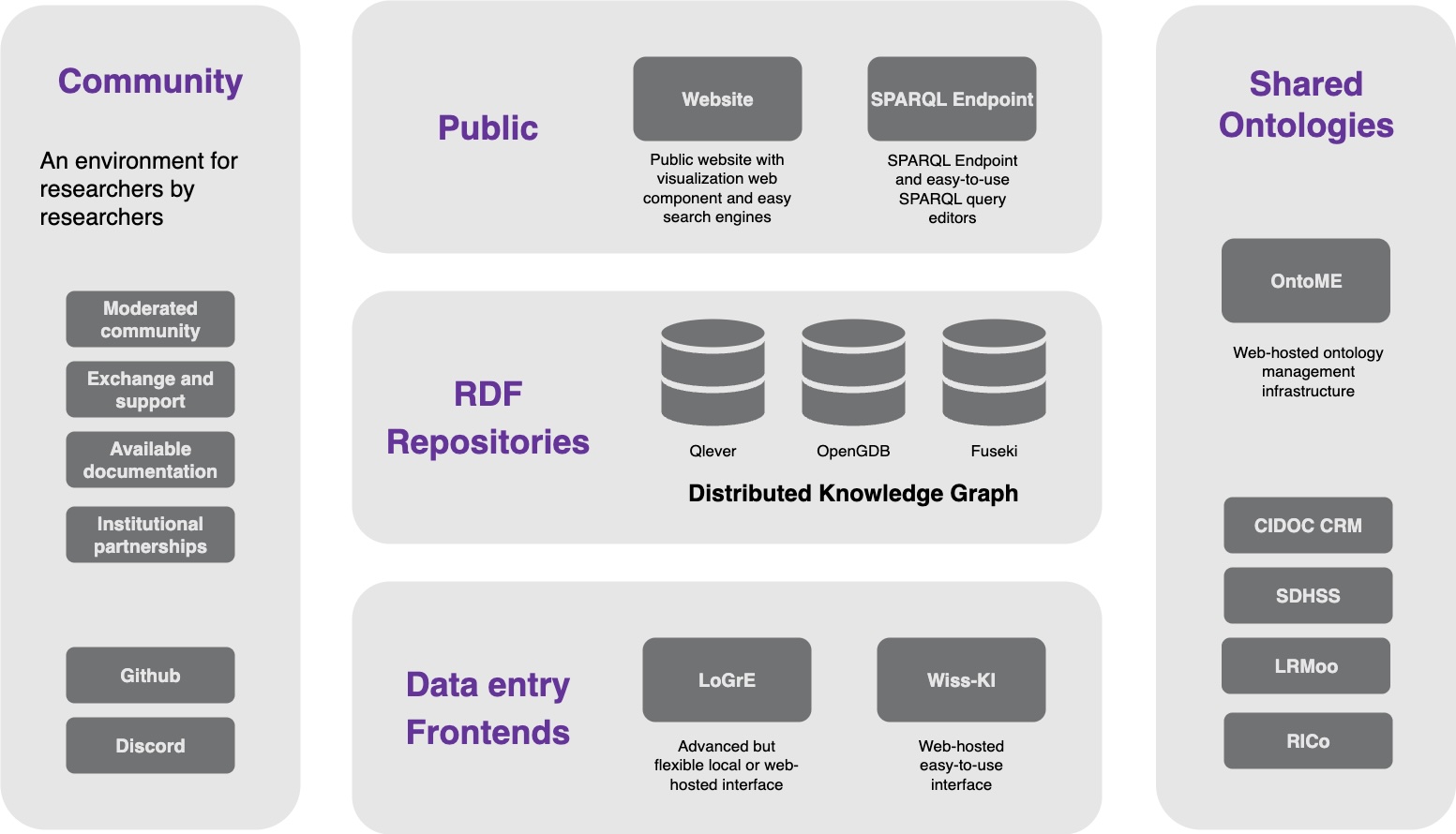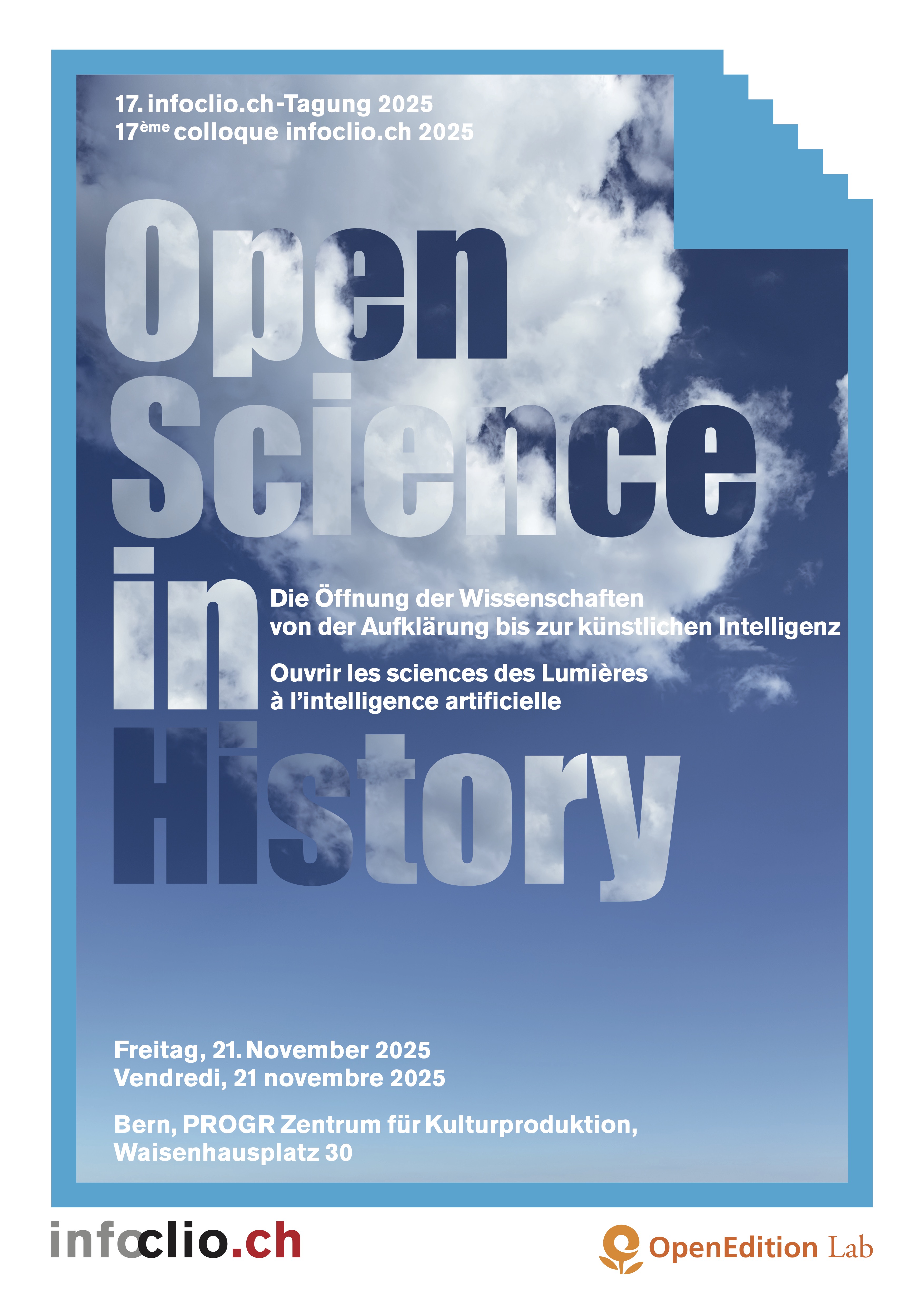This blog post, written by Stephen Hart (University of Bern) and Francesco Beretta (University of Neuchâtel), reviews the results of the «LOD4HSS» project, carried out between 2023 and 2024. It is part of a series on current developments in open data in the humanities and social sciences in Switzerland, produced for the infoclio.ch 2025 conference «Open Science in History». The series presents various recent projects, highlights resources available online, and offers reflections on the topic.
Introduction
In recent years, Linked Open Data (LOD) and Knowledge Graph (KG) technologies have emerged as powerful tools for the Humanities and Social Sciences (HSS). These technologies enable scholars to organise, link, and publish research data in ways that promote openness, semantic clarity, and interoperability—fully in line with the FAIR principles (Findable, Accessible, Interoperable, Reusable) and their aim to encourage the reuse of research data. By using LOD, researchers can publish datasets that are not only readable by machines and other scholars but also enrichable through links to external repositories. This makes it possible to formulate new research questions, perform comparative analyses, and ensure long-term data reuse.
Yet, such potential can only be realised within sustainable environments that allow researchers to produce, curate, and publish data in an efficient, reliable and cost-effective manner. This is particularly crucial in the Humanities, where financial and technical resources are often limited. It is in this context that the LOD4HSS initiative was born—an effort to develop a robust, open, and future-proof semantic information management environment tailored to the needs of HSS research.
A Short History of the Initiative
The LOD4HSS initiative builds on a vision that dates back to 2017, with the creation of the OntoME web platform (ontome.net) 1 and the launch of the Semantic Data for the Humanities and Social Sciences (SDHSS) project (sdhss.org). These initiatives were founded on the idea that research projects should not have to reinvent the wheel when it comes to modeling their data. Instead, they should rely on a shared, extensible ecosystem of well-defined ontological components that support interoperability across projects.
At the heart of this effort is the SDHSS ontology ecosystem. It provides a common semantic backbone for describing events, actors, sources, and other relevant information. It covers the basic needs of most projects but provides suitable extensions for research subdomains. Based on CIDOC CRM (ISO 21127:2014) and aligned with other GLAM standards, notably Library Reference Model (LRM) and Records in Context (RiC), SDHSS applies a methodology in ontology design that is based on an epistemological analysis of SHS information production as well as on established modelling methodologies such as OntoClean and the foundational ontology DOLCE. 2
In terms of data production, this vision was first implemented using the Geovistory platform (geovistory.org). Developed by the Swiss company KleioLab GmbH since 2017, it took advantage of the experience of the symogih.org infrastructure created by the Laboratoire de Recherche Historique Rhône-Alpes (LARHRA, Lyon) in 2008. Geovistory integrated the new OntoME and SDHSS frameworks into a modern environment in which researchers could produce, analyse, and publish data as machine-readable knowledge graphs. The identification and connection of entities managed in the different hosted projects (persons, organisations, geographical places, etc.) was realised using common Geovistory authority files. In accordance with the LOD principles, these were linked to those in repositories such as IdRef, GND, and Wikidata to enable information integration.
From 2022 onwards, the development of the platform continued as a collaboration between Kleiolab GmbH, the LARHRA and the Digital Humanities Chair at the University of Bern. Backed by the Swissuniversities-funded LOD4HSS project (2023–2024), the goal was to secure Geovistory’s future as a sustainable, community-based research infrastructure.
However, KleioLab GmbH's decision to close led to a pivotal shift. Rather than attempting to maintain a unique platform without long-term institutional support, the decision was made to transform the original toolbox-based environment into a more modular and distributed ecosystem, allowing the realisation of the original vision in a more flexible and sustainable way. It is therefore a kind of relaunch of the LOD4HSS initiative based on a new concept of infrastructure.
LOD4HSS: Towards a Distributed, Community-Driven Infrastructure Ecosystem
The transformation of the LOD4HSS initiative rests on two main pillars:
Reuse existing virtual research environments: In order to alleviate costs, it was decided that the Toolbox would be replaced by the WissKI platform—an open-source infrastructure supported by the Germanisches Nationalmuseum (https://www.gnm.de/) and developed for semantic data management and publication, fully compatible with the LOD and Semantic Web standards. WissKI offers a mature, flexible backend and a user-friendly interface for working with complex ontologies and data models. It is currently being integrated more tightly with OntoME, allowing researchers to define and reuse ontological components more easily across projects.
Developing and Integrating Open-Source Tools: In parallel, the LOD4HSS initiative promotes the development and adoption of innovative open-source tools such as the Local Graph Editor (LOGRE) based on a Shapes Constraint Language (SHACL) serialisation of application profiles managed in OntoME These tools support collaborative modelling and editing of knowledge graphs, enabling standardised, transparent, and reproducible research workflows.

Diagram of the LOD4HSS environment
Despite the virtual research environment transformation, the two key elements of the vision remain unchanged: the ontology ecosystem and shared authority files. All projects within LOD4HSS continue to rely on the SDHSS ontology ecosystem and application profiles developed and published in OntoME. This ensures semantic consistency and interoperability across different datasets produced using different tools. RDF exports produced in the former Geovistory Toolbox can still be loaded into WissKI or any SPARQL endpoint, demonstrating one of the fundamental strengths of LOD: decoupling data from platforms. As long as the data is in RDF, it remains portable and editable by a wide variety of tools.
Regarding the identification and connection of entities, the Geovistory common authority files will be replaced by Wikidata. This platform enables the addition of entities not present in other repositories, as well as the provision of the information needed to identify them. It also allows for easy connection to other authority files (IdRef, GND, BNF, etc.) if the entities are referenced there. Finally, it makes it possible to reuse apps and widgets that align existing data with Wikidata.
The Future of Linked Open Data in the Humanities
Looking ahead, the LOD4HSS initiative aims to establish a sustainable and vibrant community managing an ecosystem of projects and infrastructures for semantic research in the Humanities. By enabling connections to major authority files such as Wikidata, IdRef, GND, BNF, etc., and by encouraging the reuse of open datasets from other projects, it ensures that data produced within LOD4HSS is not only open and interoperable, but also part of a larger, interconnected scholarly web. 3
By fostering best practices, offering tools for both novice and expert users, and ensuring long-term sustainability through decentralised but interconnected infrastructures, LOD4HSS provides a model for how the Humanities can fully harness the power of semantic technologies.
In doing so, it turns a moment of transition—the end of the Geovistory platform—into an opportunity: to create a resilient, distributed, and community-governed future for Linked Open Data in the Humanities and Social Sciences.
- 1
Beretta Francesco: A challenge for historical research: Making data FAIR using a collaborative ontology management environment (OntoME), in: Semantic Web 12 (2), 2021, p. 279‑294, <https://journals.sagepub.com/doi/10.3233/SW-200416>, Accessed: 15.09.2025.
- 2
Beretta Francesco: Conceptualising Information Production in the Context of the SDHSS Ontology Ecosystem, in: Methodos 24, 2024, <https://doi.org/10.4000/12xqn>, Accessed: 15.09.2025.
- 3
Beretta, Francesco: Données liées ouvertes et référentiels public : un changement de paradigme pour la recherche en sciences humaines et sociales, in: Arabesques 112, 2024, P. 26‑27, <https://doi.org/10.35562/arabesques.3820>, Accessed : 15.09.2025.
